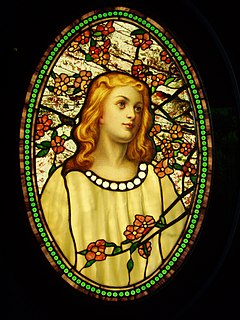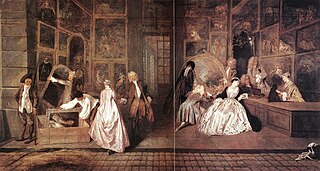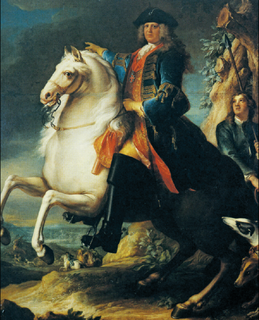
Louis Comfort Tiffany was an American artist and designer who worked in the decorative arts and is best known for his work in stained glass. He is the American artist most associated with the Art Nouveau and Aesthetic movements. He was affiliated with a prestigious collaborative of designers known as the Associated Artists, which included Lockwood de Forest, Candace Wheeler, and Samuel Colman. Tiffany designed stained glass windows and lamps, glass mosaics, blown glass, ceramics, jewellery, enamels, and metalwork. He was the first design director at his family company, Tiffany & Co., founded by his father Charles Lewis Tiffany.

Jean-Antoine Watteau was a French painter and draughtsman whose brief career spurred the revival of interest in colour and movement, as seen in the tradition of Correggio and Rubens. He revitalized the waning Baroque style, shifting it to the less severe, more naturalistic, less formally classical, Rococo. Watteau is credited with inventing the genre of fêtes galantes, scenes of bucolic and idyllic charm, suffused with a theatrical air. Some of his best known subjects were drawn from the world of Italian comedy and ballet.

Claude Gillot was a French painter, print-maker and illustrator, best known as the master of Watteau and Lancret.

A Tiffany lamp is a type of lamp with a camed glass shade designed by Louis Comfort Tiffany or colleagues, and made in his design studio. The glass in the lampshades is put together with the copper foil technique instead of leaded, the classic technique for stained glass windows. Tiffany lamps are considered part of the Art Nouveau movement. A considerable number of designs were produced, from 1893 onwards.

Clara Driscoll of Tallmadge, Ohio, was head of the Tiffany Studios Women's Glass Cutting Department, in New York City. Using patterns created from the original designs, these women selected and cut the glass to be used in the famous lamps. Driscoll designed more than thirty Tiffany lamps produced by Tiffany Studios, among them the Wisteria, Dragonfly, Peony, and from all accounts her first — the Daffodil.

Tiffany glass refers to the many and varied types of glass developed and produced from 1878 to 1933 at the Tiffany Studios in New York, by Louis Comfort Tiffany and a team of other designers, including Clara Driscoll, Agnes F. Northrop, and Frederick Wilson.

Maud Russell Lorraine Freshel was a Boston socialite, designer, and animal rights and vegetarianism activist. She also went by her initials, M. R. L., which she later spelled Emarel.

Alice Cordelia Morse was an American designer of book covers in the late 19th and early 20th centuries. Her work was inspired by the Arts and Crafts Movement, and she is often placed as one of the top three book designers of her day.

The Grueby Faience Company, founded in 1894, was an American ceramics company that produced distinctive American art pottery vases and tiles during America's Arts and Crafts Movement.

L'Enseigne de Gersaint is an oil on canvas painting in the Charlottenburg Palace in Berlin, by French painter Jean-Antoine Watteau. Completed during 1720–21, it is considered to be the last prominent work of Watteau, who died some time after. It was painted as a shop sign for the marchand-mercier, or art dealer, Edme François Gersaint. According to Daniel Roche the sign functioned more as an advertisement for the artist than the dealer.

The Country Dance is an oil painting by French artist Jean-Antoine Watteau, located in the Indianapolis Museum of Art, which is in Indianapolis, Indiana. Probably one of Watteau's earliest painting, created roughly 1706-1710, it depicts a group of quite courtly peasants dancing among the trees.

Pierre-Antoine Quillard, was a French portrait painter and engraver who worked in Portugal.
Francesca Amfitheatrof is a jewelry designer, known for her designs for Tiffany & Co.

Alice Carmen Gouvy was a designer at Tiffany Studios and worked closely with Clara Driscoll, the head of the Women's Glass Cutting Department.

Actors of the Comédie-Française, also traditionally known as The Coquettes, is an oil on panel painting in the Hermitage Museum, Saint Petersburg, by the French Rococo artist Antoine Watteau (1684–1721). Variously dated within the 1710s by scholars, the painting forms a compact half-length composition that combines portraiture and genre painting, notably influenced by Venetian school, the Le Nain brothers, and Watteau's master Claude Gillot; one of the rarest cases in Watteau's body of work, it shows five figures — two women, two men, and a black boy — amid a darkened background, in contrary to landscapes that are usually found in Watteau's fêtes galantes.

The Chord, alternatively known as The Serenader and Mezzetino, is an oil on panel painting in the Musée Condé, Chantilly, by the French Rococo painter Antoine Watteau, variously dated c. 1714–1717. Throughout the 18th and 19th centuries, The Chord passed through numerous private collections, until it came into possession of Henri d'Orléans, Duke of Aumale, son of King Louis Philippe I; as part of the Duke of Aumale's collection at the Château de Chantilly, The Chord was bequeathed to the Institut de France in 1884.

The Perfect Accord, also adapted into English as Perfect Harmony, is an oil on panel painting by Antoine Watteau, created c. 1719, now held in the Los Angeles County Museum of Art. It was the pendant to the same artist's The Surprise.

Marriage Contract and Country Dancing is a c. 1711 painting by Antoine Watteau. It entered the Spanish royal collection as part of the collection of Isabella Farnese and was recorded in the La Granja de San Ildefonso Palace in Segovia. It is now in the Prado Museum, in Madrid. It shows the signing of a marriage contract in a rural landscape.

La Boudeuse is the modern title given to an oil on canvas painting in the Hermitage Museum, Saint Petersburg, by the French Rococo painter Antoine Watteau (1684–1721). Completed in the late 1710s, La Boudeuse depicts a young couple set amidst a park in the foreground, in a rare example of the two-figure landscape composition which is considered one of the best fêtes galantes in Watteau's later work. However, the picture's authenticity was also a subject of scholarly debate, for it had been engraved by English painter Philippe Mercier, once a follower of Watteau, and was not included in Jean de Jullienne's edition of Watteau's work published in the 1730s.

Art Nouveau glass is fine glass in the Art Nouveau style. Typically the forms are undulating, sinuous and colorful art, usually inspired by natural forms. Pieces are generally larger than drinking glasses, and decorative rather than practical, other than for use as vases and lighting fittings; there is little tableware. Prominently makers, from the 1890s onwards, are in France René Lalique, Emile Gallé and the Daum brothers, the American Louis Comfort Tiffany, Christopher Dresser in Scotland and England, and Friedrich Zitzman, Karl Koepping and Max Ritter von Spaun in Germany. Art Nouveau glass included decorative objects, vases, lamps, and stained glass windows. It was usually made by hand, and was usually colored with metal oxides while in a molten state in a furnace.


















